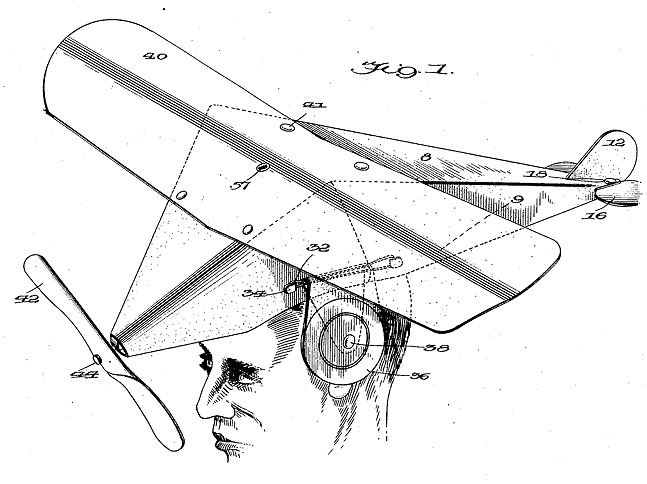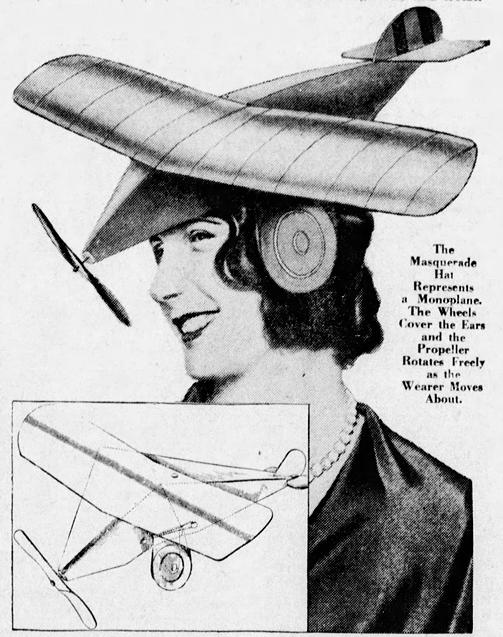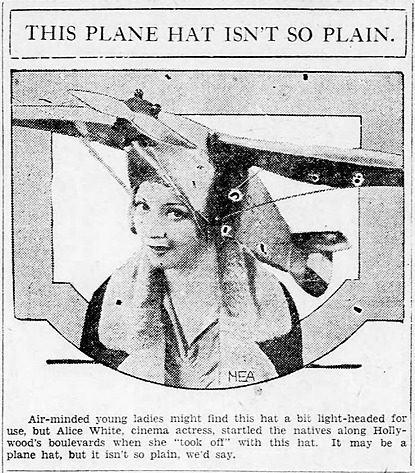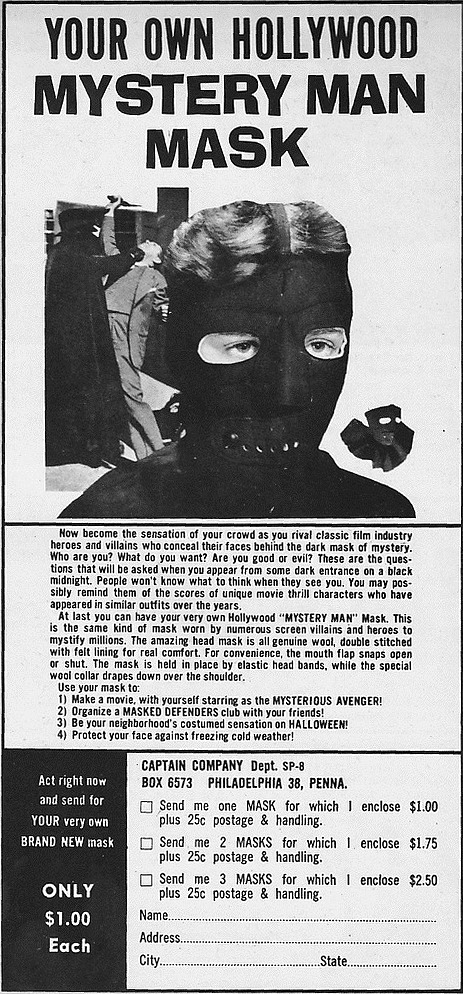Headgear
Glue-On Sweat Diverter
Rosecroft Components recently (Dec 2019) was granted a patent for a glue-on "sweat diverter". From their patent:Described herein are sweat-diverting devices which may be affixed to a wearer by an adhesive, such as a pressure-sensitive adhesive...
A sweat-diverting device may be reusable, with an adhesive reapplied for each wearing, or may be single use and disposable, with the adhesive integrated with the device during manufacturing.




Posted By: Alex - Sun Oct 25, 2020 -
Comments (1)
Category: Fashion, Headgear, Inventions, Patents, Body Fluids
Airplane Hat
Created by Gilbert Myers of Boise, Idaho. He was evidently worried that someone might steal his idea because, in 1929, he patented it. From the patent:Use of a number of novelty hats constructed as herein disclosed has demonstrated that the hat enjoys the favor of adults as well as children and may be applied to heads of various sizes in a highly convenient and expeditious manner and will remain firmly in place, all without exerting an objectionable pressure on the head.

The picture below shows the airplane hat being worn. (The accompanying article identified it as Myers's hat).

Minneapolis Star Tribune - Feb 2, 1930
These other photos, of actress Alice White, I'm not so sure about. It looks a lot like his hat. If it isn't, someone ignored his patent.


source: Flickr

Battle Creek Enquirer - Jan 14, 1930
Posted By: Alex - Sun Feb 23, 2020 -
Comments (2)
Category: Patents, Air Travel and Airlines, Headgear, 1920s
Underwear on head in restaurant
“How would you like to be eating a hamburger and turn around and see some dude wearing jockey shorts on his head?”
Indianapolis News - May 20, 1977
Posted By: Alex - Sat Oct 12, 2019 -
Comments (3)
Category: Eccentrics, Headgear, Underwear, 1970s
Wooly Wiglet Party



via Stupid Comics
Original Source: Young Love, June-July 1963
Posted By: Alex - Thu Jan 17, 2019 -
Comments (4)
Category: Headgear, 1960s
Christmas Hats

Tampa Times - Jan 4, 1939

Wisconsin State Journal - Dec 30, 1957

The Munster Times - Dec 20, 1965
Posted By: Alex - Tue Dec 25, 2018 -
Comments (2)
Category: Headgear, Christmas
Hat Guard
Back in the day when the theft of hats from hatracks was an ongoing problem, Frank P. Snow of Los Angeles patented this invention designed to inflict pain on any would-be hat thieves.A thief could take the hat, but if he tried to put it on, a "guarding prong" would jab into his skull. The prong locked in place and could only be moved if you knew the code to the combination lock.

Official Gazette of the United States Patent Office - June 2, 1914
Posted By: Alex - Thu Jun 14, 2018 -
Comments (2)
Category: Inventions, Patents, Headgear, 1910s
Kitchen Hats
Posted By: Paul - Thu May 10, 2018 -
Comments (1)
Category: Headgear, 1950s
Peekaboo Mask and Triffids
Continuing with the theme of odd masks...London designer Hugh Skillen created this unusual "peekaboo" mask in 1952.
He later went on to design the man-eating plants in the 1963 horror movie The Day of the Triffids.

Newsweek - Jan 5, 1953

Janette Scott being attacked by a triffid — via IMDb.com
Update: I tried to track down more info about Hugh Skillen and have concluded there's some confusion about his biography. Seems there were two Hugh Skillens who both lived in London at around the same time.
There was a Hugh Skillen who was a military officer who helped to develop the Enigma machine at Bletchley Park during World War II, and then later worked as a schoolmaster at Harrow County School for Boys. More info about him here.
And then there was the Hugh Skillen who was a costumier, designing costumes for theater productions in London and occasionally working on movies such as The Day of the Triffids.
I don't think these two Hugh Skillens were the same, but IMDb lists the birth/death of the costumier as being the same as the military officer: Aug 22, 1915 to Jan 4, 2004. I'm betting the info is only correct for the military officer.
Posted By: Alex - Sat Mar 17, 2018 -
Comments (0)
Category: Fashion, Headgear, Special Effects, 1950s
Freckle-Proof Sun Mask
Another addition to our collection of weird masks.Note that this sun mask came with a "breather" tube.

Phildelphia Inquirer - Jan 21, 1940

Pittsburgh Press - Feb 25, 1940

Cassville Republican - Jan 18, 1940
Posted By: Alex - Fri Mar 16, 2018 -
Comments (3)
Category: Fashion, Headgear, 1940s
Mystery Man Mask
Ads for this "Mystery Man Mask" ran in various monster-themed magazines, such as Spacemen, during the early 1960s.It made me think of some of the other creepy masks we've posted about in the past. (see below)

via The Blood-Curdling Blog of Monster Masks
Other masks previously featured on WU:



Posted By: Alex - Thu Mar 15, 2018 -
Comments (2)
Category: Fashion, Headgear, 1960s

| Who We Are |
|---|
| Alex Boese Alex is the creator and curator of the Museum of Hoaxes. He's also the author of various weird, non-fiction, science-themed books such as Elephants on Acid and Psychedelic Apes. Paul Di Filippo Paul has been paid to put weird ideas into fictional form for over thirty years, in his career as a noted science fiction writer. He has recently begun blogging on many curious topics with three fellow writers at The Inferior 4+1. Contact Us |




